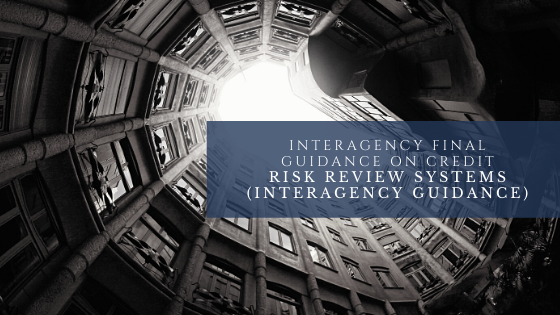On May 8, 2020, the FDIC, Federal Reserve Board, OCC and NCUA, jointly issued the final Interagency Guidance on Credit Review Systems (1). Below is a summary of the guidance as provided by CEIS Review.
This Interagency Guidance (1) replaces the guidance in– Loan Review Systems, which is part of the December 2006 Interagency Policy Statement on the Allowance for Loan and Lease Losses (2). Additionally, this aligns with the Interagency Guidelines Establishing Standards for Safety and Soundness.
Highlights:
- The guidance is designed to be commensurate with the institutions size, nature and scope of operations, loan portfolio types, risk profile, and risk management practices.
- Articulates principals for sound credit risk management including a system of independent, ongoing credit risk review and appropriate communication to management and the board of directors regarding the performance of the institutions loan portfolio; should be reviewed and typically approved annually.
- Describes a broad set of practices/principals to consider when developing and maintaining a credit risk review system, including: qualifications of review personnel; the frequency of scope, depth of reviews; and appropriate distribution of results.
- Reflects current industry best practices.
Regardless of the structure, an effective credit risk review system should meet the following objectives:
- Promptly identify loans with actual and potential credit weaknesses; appropriately validate and, if necessary, adjust risk ratings; assign accurate and timely risk ratings to all loans.
- Identify relevant trends that affect quality of portfolio.
- Assess the adequacy and adherence to internal credit policies; evaluate compliance with lending policies, quality of loan approval, monitoring, and risk assessment.
- Provide management with objective, independent and timely assessment of overall quality of loan portfolio; including appropriate ACL or ALLL.
An effective credit risk rating framework includes the following attributes:
- Ratings reflect the risk of default and credit losses with a written description of the framework including factors used to assign appropriate risk ratings to individual loans; identification of loans designated on “watch lists” that management is more closely monitoring; clear explanation why certain loans warrant special attention or have an adverse risk rating.
- Evaluation of the effectiveness of approved workout plans.
- Method for communicating timely information to management and BOD.
- Evaluation of institution’s historical loss experience.
Qualifications of credit risk review personnel:
- The level of education, experience, and extent of formal credit training is expected to be commensurate with the nature of the risk and complexity of the loan portfolios; additionally should possess knowledge of relevant laws, regulations, and supervisory guidance.
Independence of credit risk review personnel:
- An independent assessment of risk is achieved when personnel who perform the loan review do not have control over the loan and are not part of or influenced by individuals associated with the loan approval process; it is prudent for this function to ultimately report directly to the board of directors, consistent with safety and soundness standards.
Frequency of reviews:
- Typically annually, on renewal, or more frequently when factors indicate potential for deteriorating credit quality or other risk factors. Ongoing or periodic reviews are particularly important in the estimation of ACLs or the ALLL. Use of key risk indicators or performance metrics by credit risk review management can support adjustments to frequency and scope.
Scope of reviews:
- Loans over a predetermined size; a sufficient sample of smaller loans, new loans, and new loan products; loans with higher risk indicators such as credits approved as exceptions to policy.
- Segments of loan portfolios with similar risk characteristics; segments experiencing rapid growth; loans constituting concentrations of credit risk.
- Past due, nonaccrual, renewed, and restructured loans; loans previously adversely classified and watch list names warranting special attention.
- Loans to insiders or related parties; and loans to affiliates.
- Exposures from non-lending activities that also pose credit risk.
Depth of transaction or portfolio reviews:
- Credit quality, soundness of underwriting and risk identification, borrower performance, and adequacy of the sources of repayment; reasonableness of assumptions.
- Creditworthiness of guarantors or sponsors.
- Sufficiency of credit and collateral documentation; proper lien perfection.
- Proper approvals consistent with internal policies.
- Adherence to loan agreement covenants.
- Adequacy of, and compliance with, internal policies and procedures.
- Appropriateness of credit loss estimations including the reasonableness of assumptions used, and timeliness of charge-offs.
- Accuracy of risk ratings and timeliness of identification of problem loans by loan officers.
Review of findings and follow-up:
- Need to discuss review findings, including all noted deficiencies, identified weaknesses, and any existing or planned corrective actions with appropriate loan officers, department managers, and senior management; it is important to resolve risk rating differences according to a pre-arranged process.
Communication and distribution of results:
- Credit risk review typically prepares a list of all loans (and portfolio segments) reviewed, date of review, and a summary analysis that substantiates the risk ratings assigned to the loans reviewed; typically involves providing results of the credit risk reviews to the BOD or appropriate board committee quarterly.
- Comprehensive reporting includes comparative trends that identify significant changes in the overall quality of the loan portfolio, the adequacy of internal policies and procedures, the quality of underwriting and risk identification, compliance with laws and regulations, and management’s response to substantive criticisms or recommendations.
Summary
CEIS regularly reviews credit risk management frameworks either as a standalone engagement or coupled with an annual loan review program engagement. By coupling the two services together, CEIS is able to review the framework as well as the implementation of said framework to opine on the effectiveness of the established process and provide feedback for improvement if warranted.
Works Cited
- Corporation, Federal Deposit Insurance. Interagency Guidance on Credit Risk Review Systems . Washington, DC : s.n., 2020.
- Interagency Policy Statement on the Allowance for Loan and Lease Losses . Washington, DC : s.n., 2020.
- Corporation, Federal Deposit Insurance. Appendix A to Part 364—Interagency Guidelines Establishing Standards for Safety and Soundness . Washington, DC : s.n., 2020.






